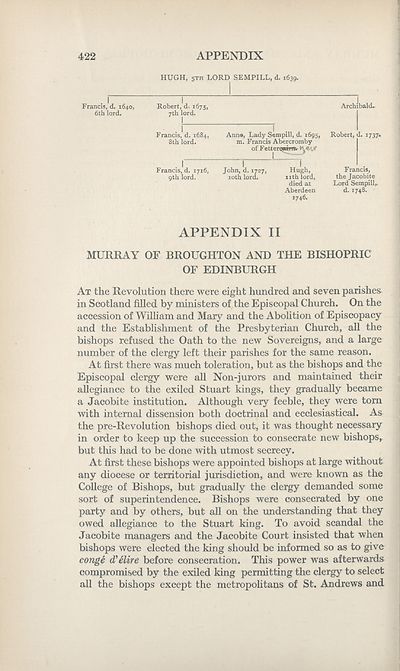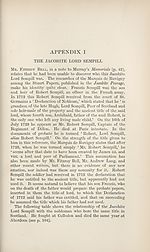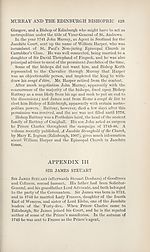Series 2 > Origins of the 'Forty-five
(519) Page 422
Download files
Complete book:
Individual page:
Thumbnail gallery: Grid view | List view

422
APPENDIX
HUGH, 5TH LORD SEMPILL, d. 1639.
APPENDIX II
MURRAY OF BROUGHTON AND THE BISHOPRIC
OF EDINBURGH
At the Revolution there were eight hundred and seven parishes
in Scotland filled by ministers of the Episcopal Church. On the
accession of William and Mary and the Abolition of Episcopacy
and the Establishment of the Presbyterian Church, all the
bishops refused the Oath to the new Sovereigns, and a large
number of the clergy left their parishes for the same reason.
At first there was much toleration, but as the bishops and the
Episcopal clergy were all Non-jurors and maintained their
allegiance to the exiled Stuart kings, they gradually became
a Jacobite institution. Although very feeble, they were torn
with internal dissension both doctrinal and ecclesiastical. As
the pre-Revolution bishops died out, it was thought necessary
in order to keep up the succession to consecrate new bishops,
but this had to be done with utmost secrecy.
At first these bishops were appointed bishops at large without
any diocese or territorial jurisdiction, and were known as the
College of Bishops, but gradually the clergy demanded some
sort of superintendence. Bishops were consecrated by one
party and by others, but all on the understanding that they
owed allegiance to the Stuart king. To avoid scandal the
Jacobite managers and the Jacobite Court insisted that when
bishops were elected the king should be informed so as to give
congk d’elire before consecration. This power was afterwards
compromised by the exiled king permitting the clergy to select
all the bishops except the metropolitans of St. Andrews and
APPENDIX
HUGH, 5TH LORD SEMPILL, d. 1639.
APPENDIX II
MURRAY OF BROUGHTON AND THE BISHOPRIC
OF EDINBURGH
At the Revolution there were eight hundred and seven parishes
in Scotland filled by ministers of the Episcopal Church. On the
accession of William and Mary and the Abolition of Episcopacy
and the Establishment of the Presbyterian Church, all the
bishops refused the Oath to the new Sovereigns, and a large
number of the clergy left their parishes for the same reason.
At first there was much toleration, but as the bishops and the
Episcopal clergy were all Non-jurors and maintained their
allegiance to the exiled Stuart kings, they gradually became
a Jacobite institution. Although very feeble, they were torn
with internal dissension both doctrinal and ecclesiastical. As
the pre-Revolution bishops died out, it was thought necessary
in order to keep up the succession to consecrate new bishops,
but this had to be done with utmost secrecy.
At first these bishops were appointed bishops at large without
any diocese or territorial jurisdiction, and were known as the
College of Bishops, but gradually the clergy demanded some
sort of superintendence. Bishops were consecrated by one
party and by others, but all on the understanding that they
owed allegiance to the Stuart king. To avoid scandal the
Jacobite managers and the Jacobite Court insisted that when
bishops were elected the king should be informed so as to give
congk d’elire before consecration. This power was afterwards
compromised by the exiled king permitting the clergy to select
all the bishops except the metropolitans of St. Andrews and
Set display mode to:
![]() Universal Viewer |
Universal Viewer | ![]() Mirador |
Large image | Transcription
Mirador |
Large image | Transcription
Images and transcriptions on this page, including medium image downloads, may be used under the Creative Commons Attribution 4.0 International Licence unless otherwise stated. ![]()
| Scottish History Society volumes > Series 2 > Origins of the 'Forty-five > (519) Page 422 |
|---|
| Permanent URL | https://digital.nls.uk/126865419 |
|---|
| Attribution and copyright: |
|
|---|
| Description | Over 180 volumes, published by the Scottish History Society, containing original sources on Scotland's history and people. With a wide range of subjects, the books collectively cover all periods from the 12th to 20th centuries, and reflect changing trends in Scottish history. Sources are accompanied by scholarly interpretation, references and bibliographies. Volumes are usually published annually, and more digitised volumes will be added as they become available. |
|---|


